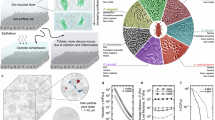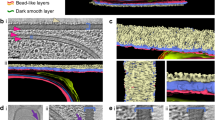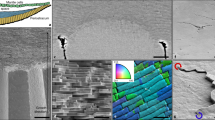Abstract
IF a cell which is topologically a sphere is covered with a coat composed of identical units arranged to form a surface crystal, this crystal necessarily1 contains screw disclinations of total strength +2 complete rotations. Harris and Scriven2 draw attention to the micrograph of a marine bacterium, Nitrosomonas, published by Watson and Remsen3, on the cover of Science, showing a coat of apparently spherical units in close packing. They say that intrinsic disclinations are strongly indicated. We have undertaken further analysis of the disclination structure of this coat.
This is a preview of subscription content, access via your institution
Access options
Subscribe to this journal
Receive 51 print issues and online access
$199.00 per year
only $3.90 per issue
Buy this article
- Purchase on SpringerLink
- Instant access to full article PDF
Prices may be subject to local taxes which are calculated during checkout
Similar content being viewed by others
References
Harris, W. F., in Fundamental Aspects of Dislocation Theory (edit. by Simmons, J. A., et al.) (National Bureau of Standards, Washington, DC, in the press).
Harris, W. F., and Scriven, L. E., J. Appl. Phys. (in the press).
Watson, S. W., and Remsen, C. C., Science, 163, 685 (1969).
Harris, W. F., and Scriven, L. E., Nature, 228, 827 (1970).
Author information
Authors and Affiliations
Rights and permissions
About this article
Cite this article
NABARRO, F., HARRIS, W. Presence and Function of Disclinations in Surface Coats of Unicellular Organisms. Nature 232, 423 (1971). https://doi.org/10.1038/232423a0
Received:
Issue date:
DOI: https://doi.org/10.1038/232423a0



